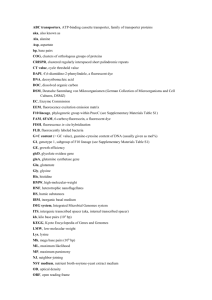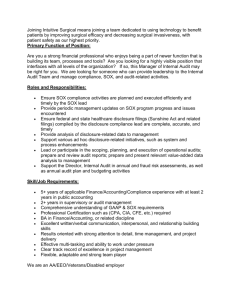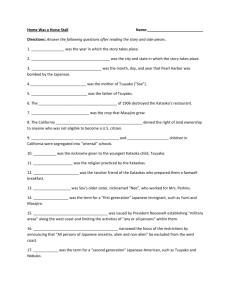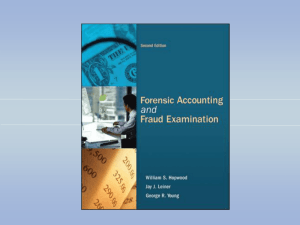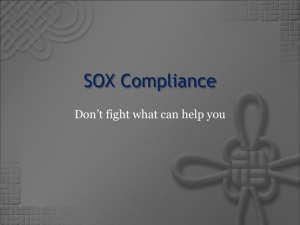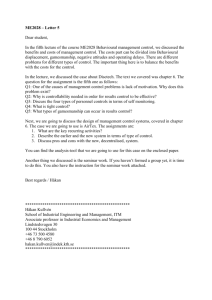Sarbanes-Oxley - Center for IT and e
advertisement
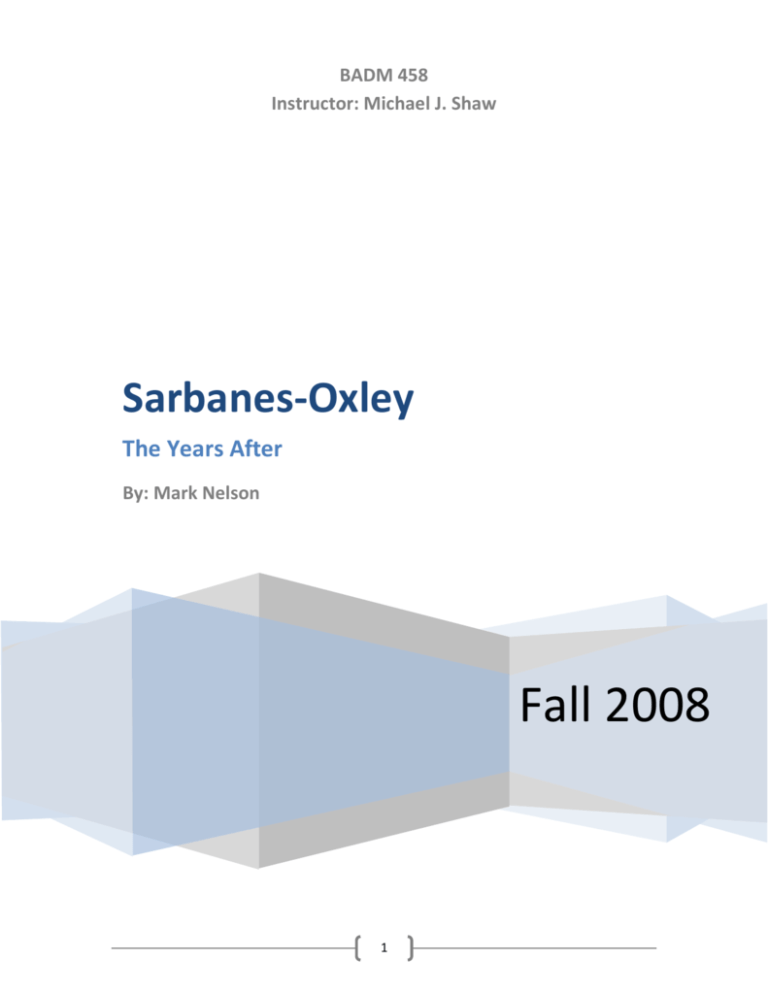
BADM 458 Instructor: Michael J. Shaw Sarbanes-Oxley The Years After By: Mark Nelson Fall 2008 1 Table of Contents Introduction ………………...…………………………………………. 3 Corporate Scandals……...………………………………………….. 4 WorldCom……………………………………………………….. 4 Enron……………………………………………………………… 5 Key Sections…………………...………………………………………. 6 Section 302………………………………………………………... 6 Section 404………………………………………………………... 7 Others……….…………………………………………………….. 8 Impact on Public Business…….…………………………………. 8 Impact on U.S. Economy............................................................... 12 Impact on Private Business…………………………………….. 13 Impact on Foreign Business……………………………………. 14 Conclusions……………………….…………………………………... 15 References…………………………………………………………….. 16 Taken from: http://www.pbs.org/nbr/site/features/special/SarbOx_home/ 2 Introduction In general, many people may not know what the name Sarbanes-Oxley, or SOX, means, but most people are able to recognize the names WorldCom or Enron. These famous debacles in business are what initiated the development of SOX. SOX is a U.S. federal act that was passed in 2002. Its name is derived from the two of the men who helped in its creation, Senator Paul Sarbanes and Representative Michael G. Oxley. The act was approved with a vast majority vote in the House of 334-90 and in the Senate of 99-0. The main goal or SOX is to minimize any events similar to Enron or WorldCom from ever happening again. It “…fundamentally stipulated that the information being reported on corporate performance within publicly traded companies must be an accurate depiction of corporate performance” (Maizlish 74). After its enactment, President was quoted as saying: “It included the most far-reaching reforms of American business practices since the time of Franklin D. Roosevelt.” It did have a very large impact on the way public U.S. businesses operated, but the reach of SOX went much farther than just the U.S. There is a unanimous agreement that SOX had a tremendous impact on the business world, but there has been a lot of speculation as to how much SOX hurt economies and private businesses. This reports aim is to describe what happened at companies such as Enron and WorldCom and justify why SOX’s enactment was so important. It will also describe the various sections of SOX and why each section is important to the overall goal of the act. Finally, a description of the impact of SOX on U.S. public and private businesses, the U.S. economy, and foreign businesses and economies after its enactment will be exemplified. 3 Section 1: Corporate Scandals Before delving into examples of scandals that happened that initiated the creation of Sarbanes-Oxley, the following graph gives an overview of the frequency of different scandals: http://www.deloitte.com/dtt/article/0,1002,sid=2007&cid=161627,00.html 1.1 WorldCom WorldCom was the United States’ second largest long distance telecommunications company at one time. It grew very quickly and ended up acquiring MCI Communications and was looking to do the same with Sprint. WorldCom seemed to be doing very well until the telecommunications downturn in 1998, shortly after acquiring MCI. A huge amount of pressure was put on the company to keep its stock from dipping lower, so executives in the company falsified their financials to make it seem like the company was actually growing when it actually wasn’t. In the end, internal auditors ended up finding $3.8 billion in fraudulent misstatements. WorldCom turned out to be a huge disaster for investor trust in large corporations. The following chart shows WorldCom’s stock before and after the investigation: 4 http://www.mgmtguru.com/mgt499/CorporateEthics.htm 1.2 Enron Enron was an American energy company whose acts of fraud and conspiracy were very similar to that of WorldCom’s. Enron had created offshore entities, units which may be used for planning and avoidance of taxes, raising the profitability of a business. This provided ownership and management with full freedom of currency movement and the anonymity that allowed the company to hide losses. These entities, along with misstatements in their accounting reports, made Enron seem like it was a very profitable company until they were revealed. Arthur Andersen, Enron’s internal auditor at the time, was also found guilty of destroying documents related to Enron’s audit and was forced to stop auditing public companies. Below is a chart depicting Enron’s stock prices before and after its lawsuit: 5 http://business.nmsu.edu/~dboje/papers/ENRON_2.jpg The events at Enron, WorldCom and numerous other publicly traded American companies called for some kind of action to be taken by government. That action was the Sarbanes-Oxley Act. Section 2: SOX’s Key Sections 2.1 Section 302: Corporate Responsibility for Financial Reports Section 302 of SOX is one of its most important sections. The following is an official statement by the Securities and Exchange Commission regarding Section 302: As directed by Section 302 of the Sarbanes-Oxley Act of 2002, we are adopting rules to require an issuer's principal executive and financial officers each to certify the financial and other information contained in the issuer's quarterly and annual reports. The rules also require these officers to certify that: they are responsible for establishing, maintaining and regularly evaluating the effectiveness of the issuer's internal controls; they have made certain disclosures to the issuer's auditors and the audit committee of the board of directors about the issuer's internal controls; and they have included information in the issuer's quarterly and annual reports about their evaluation and whether there have been significant changes in the issuer's 6 internal controls or in other factors that could significantly affect internal controls subsequent to the evaluation (Securities and Exchange Commission). Section 302 essentially made the top executives of corporations reliable and accountable for the financial statements that they provide. This will ensure that the public will be able to see an accurate depiction of how well, or how poorly, the company is doing. 2.2 Section 404: Management’s Report on Internal Controls This section of SOX turned out to be extremely important in the effectiveness of SOX on businesses. This really forced businesses to establish various internal control systems, usually IT based, that would make sure that compliance standards are being met. The internal control report must include: A statement of management’s responsibility for establishing and managing adequate internal controls over financial reporting for the company Management’s assessment of the effectiveness of the company’s internal control A statement identifying the framework used by management to evaluate the effectiveness of the company’s controls A statement that the registered public accounting firm that audited the company’s financial statements included in the annual report has issued an attestation report on management’s assessment of the company’s controls After a statement regarding the controls has been developed, then the CEOs and CFOs of the corporations must sign off on the documents to verify that they are accurate. Some companies have even forced the CIO to sign off on the documents as well to provide further verification. 404 alone has “…dramatically altered the role and function of the CIO and the governance framework within companies” (Maizlish 74-75). Section 404 is also known as the law’s most complained about provision because of the amount of compliance it requires companies to fulfill. Critics of SOX have even gone as far to 7 say that, “Whether SOX is ultimately considered a success or a failure will likely depend upon 404’s legacy” (Prentice). Many other critics believe that 404 is working, its accounting reforms have been a win, and that it is a godsend for investors. 2.3 Other Sections There are many other sections to SOX that enable it to be effective, but are not quite as critical or criticized as much as 302 and 404. Some of these other sections include 101, 102, 802, and 1107. Section 101 established the Public Company Accounting Oversight Board (PCAOB) which is charged with the registration of public accounting firms, oversee audits, and conduct investigation and disciplinary proceedings on registered public accounting firms. Section 102 established that there were now public accounting firms such as Ernst & Young and KPMG, there would be no more Arthur Andersen’s of the world. Section 802 defined the criminal penalties for companies found in infraction of SOX. Finally, Section 1107 set criminal penalties for companies that retaliate against employees who “blow the whistle.” These are not all of the other sections of SOX, but are definitely essential parts to its success. Section 3: Impact on Public Business 3.1 Varying Public Opinions After analyzing what happened at WorldCom and Enron, one should be able to see that the government’s decision to develop and enact SOX would have a major impact on the way U.S. public corporations would conduct their business. That impact has been under a lot of scrutiny from critics. Even today, critics cannot agree on whether Sarbanes-Oxley was positive or negative for American business. For example, the well-known television broadcaster PBS 8 conducted an interview with Lynn Turner, director of research at Glass Lewis and Company and former chief accountant of the Securities and Exchange Commission, and Alex Pollock, resident fellow at the American Enterprise Institute. Turner was in support of the positive effects of SOX while Pollock took a more negative stance. During the interview, Turner was quoted as saying: I do think the reports are getting better. We're not quite there yet. We still see some issues from time to time. But I think as illustrated by the number of companies that have gone out and cleaned up their reporting, corrected errors that they've had in the past, I think we are getting better and have made some real progress here. On the other hand, Pollock was quoted from the interview expressing his negative view towards SOX: The one thing we know about the effects of Sarbanes-Oxley is that it produced much more cost, paperwork and bureaucracy than anybody intended or anybody thought and the thing to remember is that cost is always paid by investors. That's by definition, bad for investors if costs are greater than benefits (Sarbanes-Oxley: Paul Kangas Interview). Also, the Chairman of the SEC, Christopher Cox, stated in 2007 that, “Sarbanes-Oxley helped restore trust in U.S. markets by increasing accountability, speeding up reporting, and making audits more independent” (Farrell). As shown, there is still a lot of separation between the opinions of people about the impact of SOX. 3.2 Research Studies and Empirical Evidence In addition to a myriad of interviews that have been conducted concerning the impact of SOX, numerous studies have been developed. Financial Executives International (FEI) conducted a survey in 2007 concerning various aspects of SOX and how well companies were complying with it. In this survey, the FEI included 168 companies that had market capitalizations above $75 million. One initial reporting of the survey was that $1.7 million was the average cost of compliance with Section 404. There were many other findings that the FEI reported in their study as well. For example, in year four of compliance, the survey showed that 9 responding companies have increased confidence in the value of Section 404 over last year's respondents: 50.3% agreed that financial reports are more accurate; up from 46% in 2006. 56.0% agreed that financial reports are more reliable, up from 48% in 2006. 43.6% agreed that compliance with Section 404 has helped prevent or detect fraud; up from 34% in 2006. 69.1% agreed that compliance with Section 404 has resulted in more investor confidence in their financial reports, up from 60% in 2006. All of these results seem to be positive and have most likely continued to rise since 2006. On the other hand, costs for corporations to comply with SOX have risen. The FEI study suggests that: Total average 2007 compliance costs for companies with centralized operations were $1.3 million; Total average 2007 compliance costs for companies with decentralized operations were $1.9 million, 30.1 percent higher than for those with centralized operations. A lot of skepticism for the cost-effectiveness of SOX has been raised because of the immense costs associated with the development and implementation of SOX controls. A few of these negative effects on U.S. public business have been that companies: Effectively paid twice as much in audit fees ($884 vs. $374 thousand per annum) Reduced their earnings through more conservative discretionary accruals Experienced worse risk-adjusted stock returns (of about 19%) over three years. Although, today those costs are becoming substantially lower. FEI explains this: Companies reported requiring an average of 11,100 people hours internally to comply with Section 404 in 2007, representing a decrease of 8.6% from the previous year. Companies reported requiring an average of 1,244 external people hours to comply with Section 404 in 2007, representing a decrease of 13.7% from the prior year of compliance. Auditor attestation fees paid by accelerated filers in 2007 constituted 23.7% of the accelerated filer's total annual audit fees and averaged $846,000, representing a 5.4% decrease from 2006. 10 All empirical information taken from: FEI Survey Another study was conducted by Institute of Internal Auditors (IAA) that provided a lot of great evidence regarding the effectiveness and acceptance of SOX in the corporate world. Their report surveys 171 chief audit executives (CAEs) and internal audit managers to help identify the specific benefits associated with Section 404 work. The following chart illustrates how these executives and managers felt about the effectiveness of Section 404: Areas of Improvement Due to 404 Work: Audit Committee Involvement and Knowledge Monitoring Controls Board Knowledge and Role In Controls Control Environment Internal Auditing Greater Acceptance of Codes of Conduct Mean Response Disagree of Strongly Disagree 9% Neutral 20% Agree or Strongly Agree 71% 11% 10% 18% 24% 71% 66% 16% 20% 18% 22% 21% 26% 62% 59% 56% 14% 22% Data taken from: Rittenberg 64% This chart provides really great evidence concluding that a lot of executives in 2005 felt that Section 404 really provided a positive influence in their business with a mean response of 64% for Agree or Strongly Agree (Rittenberg). Peter Illiev provided research that questioned whether SOX tried to do too much too quickly. His research and data allowed him to draw many conclusions regarding the effectiveness of SOX and Section 404. In this, he found that ‘Getting It Wrong the First Time,’ by Glass, Lewis and Co. shows 1,295 restatements of financial earnings in 2005 for companies listed on U.S. securities markets, almost twice the number for 2004. ‘That's about one restatement for every 12 public companies—up from one for every 23 in 2004.’ Also, Illiev concluded in his study that, “Firms’ values reacted relatively more positively to the 11 announcement of SOX” (Illiev). From the evidence illustrated in research provided above, SOX seems to be having quite a bit of positive impact on business and seems to be outweighing the costs of implementing it. Section 4: Impact on U.S. Economy Since Sarbanes-Oxley has had such a great affect on large corporations within the U.S., then it is bound to have some kind of effect on the U.S. economy as a whole. Ivy Xiying Zhang of the University of Minnesota performed a very in depth analysis of this impact. In her report, she documented that “… the market responded negatively to events that signaled increases in the likelihood of passing tough rules and positively to events revealing that no further costs would be imposed” (Zhang). This symbolizes that at first, when the SOX rules and regulations were being imposed, the market reacted negatively to it; and rightly so. Then, after a few years of companies developing compliance frameworks and with no new rules, the market reacted favorably to SOX. This conclusion seems to go along with common sense. The first graph shows the average market after SOX was first enacted in 2002 and the second graph shows the market after SOX had time to establish itself. Both charts from: http://bigpicture.typepad.com/comments/2005/06/how_much_does_s.html 12 Section 5: Impact on Private Business Private business felt the effects of SOX after its enactment along with public business. Some have already taken steps to establish an internal audit function, inducting independent board members, adopting a formal code of ethics, and many other aspects of SOX. It does not directly affect private business, but there is definitely much that can be learned from SOX for private businesses such as: Companies can increase efficiency and effectiveness Keeping good and trusting relations with customers and stakeholders Overall business integrity May not always be exempt from compliance in the future A very significant finding in the private business sector is that there have been a lot of public companies that reverted to being private after the enactment of SOX. Robert Prentice examines this topic in his research by stating: The number of companies going private did rise from in 2001 to 245 in 2004. The number of companies “going dark” (ceasing to file with the SEC, but continuing to trade in the OTC market) has also risen. The increased cost of being public caused by SOX, and particularly Section 404, is no doubt contributing both to the going private trend and to the increased tendency of firms to go dark (Prentice). The following graph illustrates that phenomenon: 1Taken from: http://www.willisms.com/archives/2006/07/index.html 13 Section 6: Impact on Foreign Business SOX definitely had a large effect on foreign companies and economies. Evidence has shown that foreign companies that are more related to companies in the U.S. are more affected by SOX regulations. Empirical research done by Kate Litvak of the University of Texas showed that: … cross-listed companies subject to the Act responded to the news of the Act’s applicability strongly and negatively, as compared to similar non-cross-listed companies. Cross-listed companies not subject to the Act responded negatively but much less strongly, again as compared to similar non-cross-listed companies (Litvak 28). The term “cross-listed” in her research is used to refer to foreign companies that had some kind of connection with one or more companies in the United States. She concluded that her findings supported investors’ views that enactment of SOX would have a negative impact on the global market initially. 14 Conclusions Since the debacles at Enron and WorldCom, the Sarbanes-Oxley Act of 2002 definitely had a significant impact in the way corporations conducted their business. Its main goal was to restore investor confidence in corporations and ensuring that every financial statement released by a company to the public contains truthful information. There are a number of sections that comprise SOX, and complying with all the various aspects of these sections has proven to be very costly and difficult for companies. Even though the costs of complying with this may be very high, research has revealed that companies have been doing very well in the years after 2002. As depicted in this paper, extensive research has been done regarding the effectiveness of SOX in companies in the U.S. and all over the world. The research has shown that the number of misstatements in companies’ financial reports has gone down, investor confidence has drastically increased, and most companies agree that complying with SOX has really helped their business. The section under most scrutiny, Section 404, has proven to be extremely effective. Critics still disagree today as to whether the costs associated with complying with SOX outweigh the benefits, but research done has shown that SOX has effective. Overall, SOX’s enactment was a pivotal development by the U.S. government. The effects of SOX have not only shown to have an impact in the large, corporate world, but have also influenced the private and foreign business sectors. Today, companies have frameworks and processes in place that are so efficient, SOX compliance is something that CIOs, CFOs, and CEOs don’t have to worry about nearly as much as they did six years ago. 15 References Farrell, Greg. Sarbanes-Oxley law has been a pretty clean sweep. 30, July 2007. 05, December 2008. http://www.usatoday.com/money/companies/regulation/2007-07-29-sarbanes-oxley_N.htm FEI Survey: Average 2007 SOX Compliance Cost $1.7 Million. 2007. 05, December 2008. http://fei.mediaroom.com/index.php?s=43&item=204 Illiev, Peter. The Effect of the Sarbanes-Oxley Act (Section 404). 25 December, 2007. 02, December 2008. < http://papers.ssrn.com/sol3/papers.cfm?abstract_id=983772> Litvak, Kate. The Effect of the Sarbanes-Oxley Act on Non-US Companies Cross-Listed in the US. 2007. 02, December 2008. < http://ssrn.com/abstract=876624> Maizlish, Brian and Robert Handler. IT Portfolio Management Step-By-Step: Unlocking the Business Value of Technology. New Jersey: John Wiley & Sons Inc. 2005. Prentice, Robert. Sarbanes-Oxley: The Evidence Regarding the Impact of Section 404. 2007. 02, December 2008. < http://ssrn.com/abstract=991295> Protiviti in-class Presentation. 3, September 2008. Rittenberg, Larry E. and Patricia K. Miller. Sarbanes-Oxley Section 404 Work: Looking at the Benefits. 2005. 04, December 2008. < http://www.theiia.org/research/research-reports/chronologicallisting-research-reports/downloadable-research-reports/?i=248> Sarbanes-Oxley: Paul Kangas Interview. 06, April 2007. 01, December 2008. http://www.pbs.org/nbr/site/onair/transcripts/070406d/ Securities and Exchange Commission. Certification of Disclosure in Companies’ Quarterly and Annual Reports. 20, August 2002. 04, December 2008. < http://www.sec.gov/rules/final/33-8124.htm> Zhang, Ivy Xiying. Economic Consequences of the Sarbanes-Oxley Act of 2002. 1, February 2008. 02, December 2008. http://ssrn.com/abstract=961964 16
